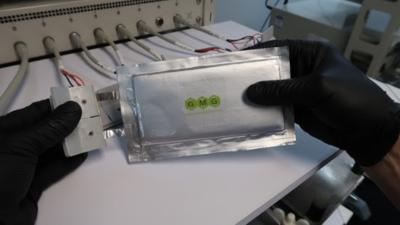Graphene batteries: Introduction and Market News - Page 4
Honeycomb Battery Company and Nubia Brand International announce closing of business combination
Last year, Global Graphene Group (G3) announced plans for its subsidiary, Honeycomb Battery, to merge with a SPAC company (Nubia Brand International Corp.) in a deal worth $925 million. Earlier this month, it was announced that this business combination was completed.
Upon the completion of the business combination, the combined company was renamed Solidion Technology. Beginning on Monday, February 5, 2024, Solidion’s common stock was expected to begin trading on the NASDAQ Global Market under the new ticker symbol “STI.”
GMG updates on progress of its graphene-aluminum batteries
Graphene Manufacturing Group (GMG) has provided a progress update on its Graphene Aluminum-Ion Battery technology being developed by GMG and the University of Queensland (UQ).
The Company has announced it has produced multiple battery pouch cells with over 1000 mAh (1 Ah) capacity. In a recent build to confirm repeatability, the Company's development team has built and confirmed multiple cells, all reportedly testing greater than 1Ah (1000mAh). This is defined by GMG as "a major milestone achieved to demonstrate scalability from coin cells to pouch cells".
Lyten secures $4 Million grant from Department of Energy
Lyten has announced it has secured a $4 million grant from the U.S. Department of Energy (DoE) to accelerate the manufacturing of its advanced lithium-sulfur battery technology. This grant (awarded by the DoE’s Energy Efficiency and Renewable Energy / Vehicle Technologies Office) specifically targets lithium-sulfur technologies that can alleviate offshore supply chain risk for EV batteries and increase EV driving range.
Lithium-sulfur is a chemistry known for decades to potentially hold 2 to 3 times the energy density of lithium-ion but was not envisioned to come into the market until the 2030s due to material science challenges. Lyten set out to accelerate this timeline by using its 3D Graphene material to develop a sulfur-graphene composite cathode. In June 2023, Lyten opened a semi-automated lithium-sulfur pilot line producing pouch and cylindrical cells on its 145,000-square-foot campus in Silicon Valley and will begin to deliver non-EV cells commercially in 2024.
India-based Ipower Batteries launches graphene series lead-acid batteries
According to a recent announcement, India-based IPower Batteries has launched graphene series lead-acid batteries.
The company has claimed its new battery variants have been tested by ICAT for AIS0156 and have been awarded the Type Approval Certificate TAC for their innovative graphene series lead-acid technology.
Nanotech Energy announces its graphene-based batteries are available for pre-order
It was recently announced that Nanotech Energy is offering its graphene-based 18650 cells for pre-order through its commercialization partner, Voltaplex.
The cells bring together Nanotech Energy's electrolyte and proprietary electrodes with Soteria metallized polymer current collectors to create a major advancement in battery technology. The result, as per the Company, is a 100% American-made non-flammable lithium-ion battery pack that has shown its strength and flexibility survived a remarkable abuse trial.
Nanotech Energy announces launch of graphene batteries production plant Chico 2
Nanotech Energy has announced that graphene-based battery cells will go into full production in early 2024 at its new 150MW manufacturing facility Chico 2.
Nanotech Energy successfully completed trial weeks at Chico 2 in November and December. Almost all equipment is now in place at the Chico, CA site, and final processes are being refined ahead of a launch that will eventually generate 30,000 18650 battery cells per day.
Directa Plus enters deal for system to be used for graphene compounds
Directa Plus has revealed that it has signed a deal with an unnamed Italian innovator to buy the technology for a system capable of preparing tailored graphene compounds. According to the Company, this technology will initially be used in batteries and polymers.
It explained that the acquired know-how and technology would help to enable the dry encapsulation of G Plus graphene nanoplatelets into different compound carriers for different exacting applications.
NanoXplore announces commissioning of graphene-enhanced silicon and anode active material pilot lines
NanoXplore has announced the successful commissioning of two anode material pilot lines, reportedly achieving remarkable energy density and product validation. The Company called this 'a pivotal moment in NanoXplore’s ongoing commitment to advancing sustainable energy storage solutions'.
NanoXplore’s proprietary silicon graphene technology (SiG™) produced in the pilot line, has achieved an energy density of 1150 Wh/L, and demonstrated compatibility with conventional graphite anodes, resulting in an energy density of over 800 Wh/L. NanoXplore remains dedicated to pushing the boundaries of energy storage capabilities using its advanced materials technology. The SiG™ family is supported by 11 patents which cover a range of different chemistries and extend to all cylindrical cell form factors.
Nanotech Energy in search of new US brownfield gigafactory site
U.S-based graphene batteries developer Nanotech Energy has stated its intention to secure a new US brownfield gigafactory site early in 2024 that will accelerate its commercialization of graphene-based non-flammable lithium-ion batteries.
The announcement follows Nanotech Energy's successful sale of its Reno, NV, site and represents the Company's ambition to satisfy increased customer demand. It plans to use the site for an up to 6GWh-per-year plant, marking the next step in its journey to bring US-made fast charging, high energy density and inherently safe batteries to market. The Company hopes the new gigafactory will be operational in 2025.
Researchers develop antimony alloy based reduced graphene oxide composite for faster charging sodium-ion batteries
Researchers from the University of Hyderabad (UoH) and the Tata Institute of Fundamental Research (TIFR) have developed electrode materials made of Tin antimony alloy based reduced graphene oxide composite which has the potential to enhance energy storage for sodium-ion batteries.
Sodium-ion batteries could offer enhanced energy efficiency, rapid charging capabilities, resilience to extreme temperatures, and safeguards against overheating or thermal runaway incidents. They exhibit reduced toxicity due to their lack of reliance on lithium, cobalt, copper, or nickel, which have the potential to emit environmentally harmful gases in the event of fire, according to a recent official release.
Pagination
- Previous page
- Page 4
- Next page


